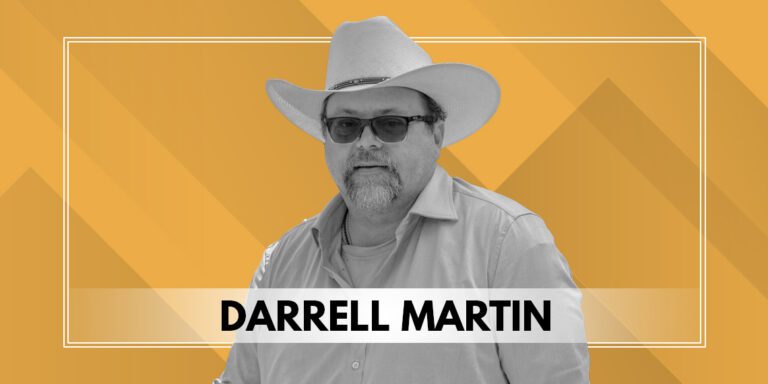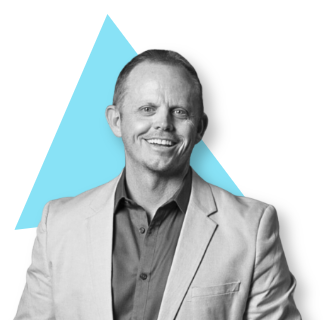"Balance is everything. I learned this through a group called Rise Up Kings, which focuses on family, finance, faith, and fitness."
Darrell Martin is a self-made entrepreneur with a sharp business mind and a passion for innovation. As the founder of APEX Trader Funding, he built a successful career in trading, investments, and business education. Still, his true passion lies in the equine industry, where he is now making a significant impact.
Raised in Texas, Martin spent summers on his family’s ranches, fostering a deep connection to horses. His daughter, Felicity, is already a barrel racing champion, securing AQHA world titles and top finishes in elite competitions. Inspired by her success, Martin has leveraged his strategic vision to establish 4M Equine Ranch, a breeding and training program with industry-changing potential.
What began as a competition arena has evolved into a state-of-the-art therapy and training center featuring advanced recovery and performance technology. More than breeding champions, Martin aims to elevate the entire industry, ensuring his horses and the sport reach new heights. With top-tier bloodlines, world-class training, and cutting-edge facilities, 4M Equine Ranch is poised to become a leading force in modern barrel racing.
WOULD YOU LIKE TO GET FEATURED?
Grow Your Brand and Authority in Our Global Magazine
Can you tell us about your journey and how you got involved in the equestrian and rodeo industry?
Darrel Martin: We started by transforming our stables into a therapy center for our horses and later for outside horses. That initiative expanded rapidly, evolving into a full-scale facility where we could host barrel races, roping events, and clinics. As we developed this, I saw an opportunity to acquire some top-tier stallions, which led us into the breeding business.
We invested in some exceptional studs, and one of them has now surpassed $5 million in earnings, ranking among the top 12 stallions of all time. From there, we expanded further by acquiring high-caliber mares—around 15 initially, with impressive records, including NFR competitors and six-figure earners. Eventually, we grew to own over 130 broodmares because, for every foal you plan to breed, you need a solid foundation of quality mares. Now, we’re building our foaling barn and lab, ensuring everything is in place to produce the best future champions.
What inspired you to innovate within the rodeo industry, particularly with timing technology?
Darrel Martin: I became passionate about timing accuracy after realizing how outdated the current systems were. In speed events, fractions of a second can make or break a competition, yet the existing timing methods were often inaccurate by up to half a second. That’s a huge margin when prize money and titles are at stake.
I saw an opportunity and acquired a timing technology company, improving and refining it to bring accuracy and fairness to the competition. We’ve since developed a next-generation timer, got it officially approved, and are rolling it out to top rodeo events
Transitioning from ranch horsemanship to competitive rodeo must have come with challenges. How did you navigate that shift?
Darrel Martin: When my daughter got into rodeo 10-12 years ago, I had a major learning curve. I knew horses and ranch work, but rodeo is a different world with its own specialized tack, techniques, and strategies. To bridge that gap, I sought out the best coaches in the industry, like Charmaine James and Paul Humphrey, to train her.
There were plenty of mistakes along the way—I bought a few bad horses early on, and we worked with some coaches who weren’t the right fit. But my daughter had the right mindset: she was open to learning, trying out different coaching styles, and absorbing what worked for her. That dedication paid off—she has now won 12+ world titles in barrel racing, ranked third in the world in cutting, and second in working cow horse.
Your focus on innovation extends beyond training. You’ve invested heavily in arena surfaces. Why is that?
Darrel Martin: A good arena starts from the ground up—literally. My daughter was in a serious rodeo accident, and her helmet saved her life. That made me hyper-aware of arena surfaces and rider safety.
We took core samples from top arenas, studied their compositions, and recreated optimal footing. We also invested in precision laser-leveling technology to ensure perfectly even surfaces and eliminate hazards that could trip up horses. Riders have told us they love it. In fact, at our last race, the only two falls happened because the horses bucked—not because of the ground. That’s the goal: a safe, consistent riding surface.
Acquiring a rodeo tech company is a unique move. What gaps did you see, and how have you improved the technology?
Darrel Martin: When I acquired the timing company, I immediately noticed a critical flaw in how rodeo events were being timed. Most systems relied on a single laser beam to detect when a horse crossed the finish line. The problem with this method is that horses don’t always carry their heads at the same height—some have their noses up, others stretch forward, and some keep their heads lower. This inconsistency caused errors in timing, sometimes delaying the stop of the clock by fractions of a second.
Now, in rodeo speed events, a fraction of a second can mean the difference between winning and losing thousands of dollars. Imagine a $50,000 check being decided by a timing error. It’s unacceptable. I knew there had to be a better way to make results 100% accurate and fair.
To fix this, we developed a multi-laser system that ensures accurate detection regardless of a horse’s head position. We tested it at the World Professional Rodeo Association (WPRA) World Show, comparing it to existing systems, and based on feedback, we created a version 2.0 with key improvements:
- Backup Frequencies and Multiple Connections – Prevents failures, ensuring the timer always works.
- AI Recognition Technology – Stops false triggers from tractors, judges, or dust.
- Adjustable Laser Heights – Works for all horse sizes, from ponies to tall quarter horses.
These upgrades bring unmatched precision to rodeo timing. Our goal is to make this system the new industry standard, ensuring fair, accurate results at every level of competition.
Your approach to business isn’t just about innovation but also about team building. How do you build and retain talent?
Darrel Martin: We’ve had a solid team from the start, with a few natural changes as we’ve grown. The key is finding people who are loyal to the vision, not just their personal brand. In a competitive industry like rodeo, many riders and trainers want to build their own name—and that’s great—but they need to align with our mission, too.
One strategy we’ve used is bringing in top specialists rather than expecting a single rider or trainer to do it all. Instead of relying on one person to break, train, and compete, we built a team of professionals in each area. For example, we brought in Emily Bezel, a six-time NFR competitor, to help elevate our program.
With so many moving parts, how do you balance business growth with family?
Darrel Martin: Balance is everything. I learned this through a group called Rise Up Kings, which focuses on family, finance, faith, and fitness. At one point, I got too caught up in the business side, but I’ve since prioritized family—spending time with my wife, being present for my kids, and letting work wait when it needs to.
My daughter is following her passion and plans to become an equine surgeon. When she returns from vet school, we’ll have state-of-the-art technology in place for her to launch a veterinary service within 4M Equine.
What impact do you hope to have on the rodeo industry?
Darrel Martin: One major shift we made was becoming the first ranch to sponsor all barrel racers at the circuit finals. Riders invest everything to stay on the road, and we wanted to make the sport more viable for them.
The biggest technological impact we’re making is with timing accuracy. We’re now rolling out eight-laser timing systems to replace outdated single-beam setups, ensuring competitors get the fairest and most precise timing possible.
We’re also expanding into roping, rough stock, and other rodeo disciplines to modernize outdated systems. Many rodeo tech companies stopped innovating, forcing competitors to buy outdated parts from eBay. We’re changing that by integrating our new timing tech into multiple disciplines.
What’s your long-term vision for 4M Equine?
Darrel Martin: Our core focus is breeding and producing elite-level horses. We currently have five stallions and 40 foals, and we’re focused on developing top-tier bloodlines.
But beyond breeding, our goal is to revolutionize rodeo technology. Within a year, we want to see our timing systems used at NFR, Rodeo Houston, Fort Worth, Calgary, and Pendleton. We also plan to reintroduce tech into neglected rodeo areas where companies have stopped innovating.
Ultimately, success will be when we see our technology and horses dominating the industry—both in the arenas and in the breeding barns.
As your business has grown, how has your role evolved, and where does your true passion lie?
Darrel Martin: My passion has always been innovation and strategic growth rather than day-to-day operations. I’m not the person who oversees every small detail—I focus on big-picture planning and ensuring we have the right team in place to execute that vision.
I’ve learned that my strength lies in identifying opportunities, making deals, and assembling a talented team that can bring those ideas to life. That’s been a key factor in our success—finding the right people and giving them the space to execute at a high level.
So your approach is to set the vision, bring in the best people, and let them execute?
Darrel Martin: Exactly. I believe in setting the direction and then trusting my team to handle the execution. Of course, I still check in and ensure things are running smoothly, but my role isn’t micromanaging—it’s about building a system that functions efficiently without me needing to be involved in every single detail.
We’ve brought in top experts, including professionals with PhDs in laser technology, engineers, and specialists in different aspects of the industry. The team we’ve assembled is truly impressive, and that’s what allows us to continue pushing forward.
Team-building has been a major part of your success. How do you approach hiring and keeping the right people?
Darrel Martin: One of the biggest lessons I’ve learned is that you want people loyal to the vision, not just to build their brand. In competitive industries like rodeo, many professionals want to make a name for themselves, which is understandable. Still, for our business to succeed, it needs to be aligned with what we’re trying to achieve as a company.
We’ve been fortunate with our team, and we’ve also learned that sometimes, roles need to evolve as we grow. It’s not necessarily about replacing people but about making sure everyone is in the right position to contribute best. That’s why we’ve moved toward specialized roles rather than expecting one person to do everything.
For example, instead of relying on one rider to break, train, and compete with horses, we bring in specialists for different disciplines—from futurity to cutting to barrel racing. That approach has made us more effective and has elevated the quality of our program.
What does success look like for you? How will you know when you’ve truly accomplished your vision?
Darrel Martin: Success will be defined by a few key milestones. First, I want to see our timing technology in rodeo arenas everywhere, ensuring that competitors get the most accurate and fair results possible.
Beyond that, a major goal is to see my daughter launch an equine surgery practice within 4M Equine. She’s been working toward becoming an equine surgeon, and we’re building the infrastructure so that when she finishes her training, she’ll have a state-of-the-art facility ready to go.
And finally, success means producing top-tier horses that dominate the industry. Not just the ones we own but also the ones we sell—seeing our 4M bred horses winning at the highest levels would be the ultimate confirmation that we’ve built something great.
Disclaimer: The ValiantCEO Community welcomes voices from many spheres on our open platform. We publish pieces as written by outside contributors with a wide range of opinions, which don’t necessarily reflect our own. Community stories are not commissioned by our editorial team and must meet our guidelines prior to being published.
Read Special Edition Articles
- 10 Traits of Highly Successful Entrepreneurs
- Unlocking the Secrets of Smart Goal Setting Leads to Success
- Maximizing the Power of Networking: The Key to Growing Your Business
- Conquering the Top 5 Most Common Challenges Faced by Entrepreneurs
- Discovering the 3 Essential Steps to Building a Strong, Effective Team as a Startup Founder
- The 7 Key Roles of Market Research in Startup Success
- 5 Ways to Unleash the Benefits of Mentorship for Entrepreneurs
- Mastering Financial Management: The Key to Success for Small Business Owners
- The Impact of Artificial Intelligence on Job Markets
- Resilience and Persistence: The Two Essential Ingredients for a Successful Business






